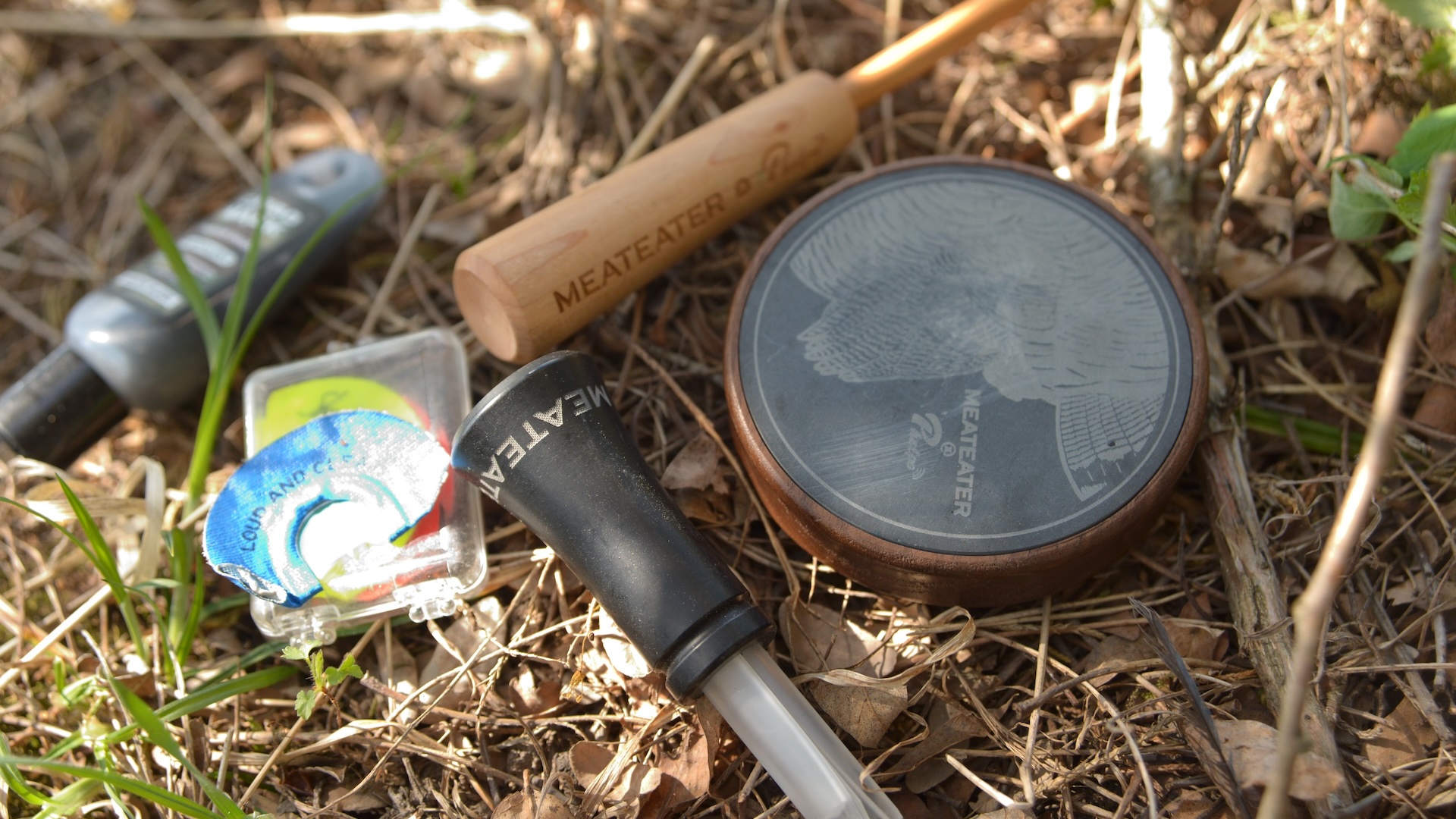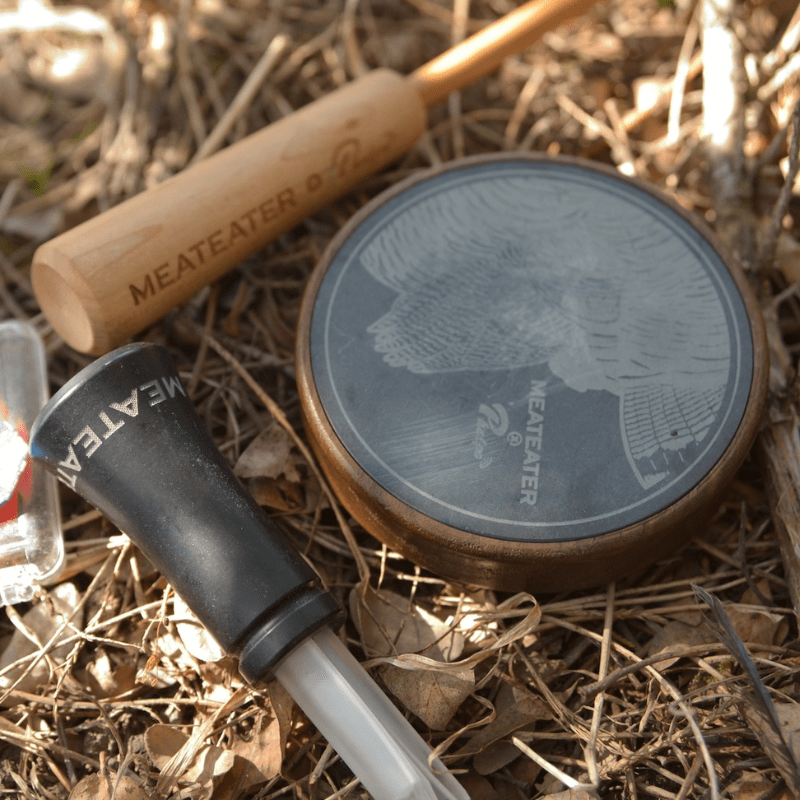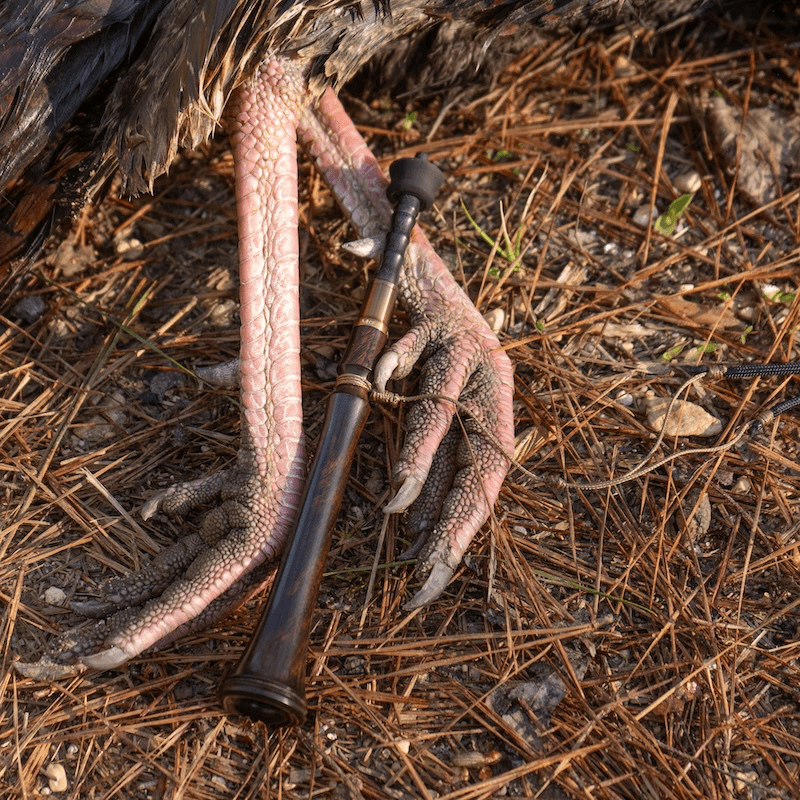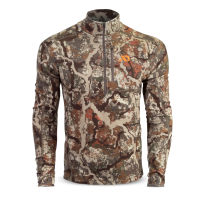
The best turkey calls are the ones that convince that longbeard to close the distance. Some days, that call might be a diaphragm; others, the trusty box or slate. Sometimes, it helps to throw something they haven’t heard from every other hunter, like a trumpet, natural voice calls, or a snuff box.
I’ve hunted birds that made me open every pocket in my turkey vest before they responded. For that reason, you should carry an array of calls. Even then, there’s no guarantee, but this list should serve as a starting point.
The MeatEater crew has bagged longbeards all the way from Washington to South Florida, so we’ve seen our share of stubborn gobblers. Whether we’re chasing Merriam’s or Easterns, these are the best turkey calls we’ll use this spring.

You’ll notice that most of our choices here are Phelps, and that’s no coincidence. Phelps is part of the MeatEater Family of brands because we believe they make the best damn game calls, hands-down. You can read more about our partnership here.
Jump to: The Best Turkey Calls
What to Look for In a Good Turkey Call
When it comes to turkey calls, the options seem endless. To be honest, there are plenty of solid options out there that didn’t make this list. As long as you find one that you can run successfully, stick with it. The ones we prefer feature these qualities:
- Realistic Turkey Sounds
- Ease of Use
- Versatility
Jump to: What Makes a Good Turkey Call
The Best Turkey Calls
 MeatEater x Phelps Purpleheart/Sapele Box Call Jason Phelps' Pick
|
 MeatEater X Phelps Slate Over Glass Janis and Tony's Pick
|
 Newcomb Prime Cut Clay's Pick
|
 AGE Trumpets XT Adam's Pick
|
 Harrison Hooter Owl Call Jason Phelps’ Pick
|
|
|---|---|---|---|---|---|
| Highlight | Best Box Call | Best Pot Call | Best Mouth Call | Best Trumpet Call | Best Locator Call |
| Pros | Wide volume range, Rich two-tone yelps, Beginner-friendly, High-quality wood | Unbelievable sound, Easy to use, Low maintenance surface, Versatile | Versatile, Short learning curve, Plenty of rasp | Heirloom turkey call, Work of art, Wide volume range, Requires minimal air, Ultra-realistic turkey sounds | Extremely realistic, Dual-tone ports allow for natural sounds, Weather resistant |
| Cons | Not hands-free, Bulky | Pricey | Cut might not be optimal for some | 1-year waitlist, Expensive, Not hands-free | User-friendly |
| Price | $88* | $88* | $35 (three pack)* | $200 and up* | $59* |
| Field Notes | Field Notes | Field Notes | Field Notes | Field Notes |
What Makes a Good Turkey Call
Realistic Turkey Sounds
Ease of Use
Versatility
You might find a turkey that gobbles at a slammed truck door, but those kinds of willing longbeards don’t strut around every corner. More often than not, you need a call that produces crisp, realistic sounds. No two turkeys sound the same, but they definitely don’t sound like a sick dog. Whether you prefer more rasp, clean notes, or a variety of tones and pitches, just make sure it sounds like a turkey.
It takes little movement to put a turkey on edge. Your call should require minimal effort to produce realistic turkey sounds. If not, you might want to consider finding another one. You can run a mouth call hands-free, while boxes, pots, and others require two-handed operation. Consider these factors before you buy one.
The best turkey calls can produce a variety of realistic turkey sounds. The more turkey vocalizations on a single call, the less you’ll have to dig in your vest to find another one.
Field Notes from the MeatEater Crew
Jason Phelps' Pick
Best Box Call
Boxes epitomize classic turkey calls. They’re reliable, easy to maintain, user-friendly, and they can help you strike a gobbler that’s a country mile away.
"When I need a loud, crisp, and raspy turkey call, I prefer the MeatEater x Phelps Purpleheart/Sapele Box Call," Jason said. "The Purpleheart lid combined with the Sapele box produces sharp, high-pitched yelps that cut through high wind days, making it perfect for locating gobblers at a distance."
A lot of hunters view box calls as outdated or a beginner’s tool, but they would be sorely mistaken. In the right hands, a good box call can produce ultra-realistic turkey sounds just as good as any other call. In fact, Jason pointed out the Purpleheart’s versatility as one of the reasons he keeps this call in his vest.
"One of the best things about this call is its versatility," he said. "You can get soft clucks and purrs in close quarters, but when it’s time to fire up a tom, this box call commands attention."
Pros
- Wide volume range
- Rich two-tone yelps
- Beginner-friendly
- High-quality wood
Cons
- Not hands-free
- Bulky
Janis and Tony's Pick
Best Pot Call
Most turkey hunters, myself included, carry some type of pot call in their vest either as a primary or backup option. They typically provide a shorter learning curve than a mouth call and are more forgiving than others when you goof up. You can also make any turkey vocalization you need with a good slate or glass call, as long as you keep the surface conditioned and remember to practice. Pot calls offer a ton of versatility when it comes to calling, which is why MeatEater’s Janis Putelis and Tony Peterson keep the MeatEater X Phelps Slate Over Glass in their turkey vests at all times.
"I carry all the calls," Janis said. "but my go-to, if I have the time and cover to work it, is the MeatEater X Phelps Slate Over Glass. It has the leniency to cover my poor strokes, and it’s the call I recommend to beginners."
Slate offers one of the most forgiving surfaces, and it doesn’t take a ton of effort to make realistic turkey sounds, especially soft ones. Most hunters can crank out loud yelps, but the wariest gobblers typically respond to soft, subtle calls, which becomes critical in close-quarter situations.
"I bowhunt turkeys a lot, which means I need to talk them into under 10 yards," Tony said. "I typically do this by pairing a mouth call with a high-quality slate like the MeatEater X Phelps Slate Over Glass. I can produce loud, crisp yelps and cutting, but also dial it way down when birds get close or I have hens in my spread. For a slate, I don’t think there’s a better option."
Pros
- Unbelievable sound
- Easy to use
- Low maintenance surface
- Versatile
Cons
- Pricey
Clay's Pick
Best Mouth Call
Finding the best turkey mouth call requires a bit of trial and error, especially if you want one that fits your mouth and runs the gamut of turkey vocalizations. Of course, you could design one tailormade for your calling style like Clay Newcomb did with his Newcomb Prime Cut diaphragm from Phelps Game Calls.
"The Newcomb Prime Cut call features three reeds with a unique ‘cottonmouth’ cut on top," Clay said. "I can make everything from raspy yelps to soft purrs."
Rather than carry a host of calls, Clay prefers a few that allow him to make all the turkey vocalizations he needs. He helped design the Newcomb Prime Cut to do just that.
Pros
- Versatile
- Short learning curve
- Plenty of rasp
Cons
- Cut might not be optimal for some
Adam's Pick
Best Trumpet Call
Anthony Ellis, a custom call maker and owner of AGE Trumpets in Chatsworth, Georgia, makes some of the finest trumpets you can get your hands on. He’s earned numerous awards for his calls. Most recently, he took home first in the trumpet division at NWTF’s Grand National Callmaking Competition, as well as the best-in-class Tom Turpin award in 2020. His accolades rival that of his waitlist, which currently sits at one year. After getting my hands on a few, I assure you they’re worth the wait.
Unlike other trumpets, the XT requires little air to run and produces easy, clear hen yelps, clucks, or cutts. With practice, you can manage soft purrs or dial in the rasp to your liking (play around with the lip stop positioning to do this). The barrel design and bell shape make it easy to vary the amount of backpressure you apply when calling.
Some hunters might see the price as steep. After all, $200 (and up) isn’t pocket change for a turkey call. But we’re not talking about mass-produced yelpers here. Ellis’ trumpets represent handcrafted heirlooms. His craft and dedication to call-making shine through in each finely tuned barrel. They’re downright beautiful. You’ll hesitate to tote one of these calls for fear of tarnishing it, but AGE trumpets aren’t meant for a shelf.
Pros
- Heirloom turkey call
- Work of art
- Wide volume range
- Requires minimal air
- Ultra-realistic turkey sounds
Cons
- 1-year waitlist
- Expensive
- Not hands-free
Jason Phelps' Pick
Best Locator Call
Unless you’ve practiced enough to master a natural owl hoot, it’s handy to have a dependable locator call. A lot of cheap, mass-produced hooters scream imposter, and anybody with an ear can pick them out. To create an ultra-realistic hooter, Phelps Game Calls teamed up with grand national calling champion James Harrison to produce the small batch, U.S.-made Harrison Hooter Owl call. Here’s what Jason Phelps had to say about it.
"The Harrison Hooter Owl Call is one of the most realistic owl calls I’ve ever used," he said. "It produces deep, throaty owl sounds, and the dual-tone ports allow you to add natural depth and volume to your hoots."
Like any call, you’ll need to practice to get the most out of it. Try listening to real owls to figure out the cadence and varied pitches to make the most realistic sounds.
Pros
- Extremely realistic
- Dual-tone ports allow for natural sounds
- Weather resistant
Cons
- User-friendly
Last Shot
Before I found a few of the best turkey mouth calls, I was never satisfied with the ones I tried, so I took up natural voice calling. I ended up calling almost exclusively with my natural voice for several years and tagged more than a few longbeards doing so. Killing some of those gobblers with nothing more than my voice made for some of the most rewarding and exciting hunts I’ve experienced.
Voice calling might require more of a learning curve than any other calls, but it’s a handy skill to have. You might have volume limitations, but you still have plenty of options when it comes to sound manipulation. Once you practice enough, you’ll figure out how to easily break those two-note yelps, purr quietly, and even sound like multiple turkeys. It won’t cost you a dime, but you might leave the turkey woods with a sore throat. Regardless, it’s a good skill to learn because if you happen to lose your mouth call or leave your turkey vest at home, you’ll never be without a call.











